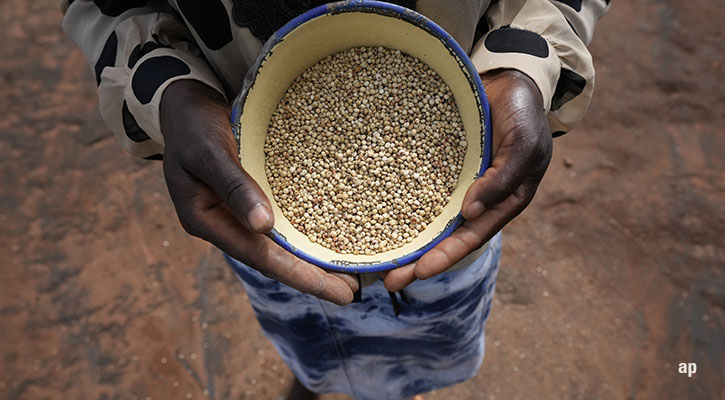
News that Ukraine can continue to export grain deal from Black Sea ports was received with relief by European governments last month. This was one of many commodity pinch points exposed by the Russian invasion of Ukraine in February 2022 – a subject we have covered as part of our look at Europe one year after the conflict broke out.
Pressures on the global food distribution network continue, however, and they are being felt across rich and poor nations – from missing salads in UK supermarkets to chronic food shortages in Tunisia. Every crisis, especially one that involves spikes in prices, attracts speculation and opportunism. With food, there are significant ESG risks, but there are also opportunities as the world tries to feed more people in a sustainable way.
Square Meals, Squaring The Circle
There are plenty of access points for investors playing witness to the food supply crisis. As a so-called "soft" commodity, grains, wheat and cereal are often overlooked by investors focusing on oils and metals. But investing in food supply and demand is nothing new: traders started buying and selling "pork belly" futures on the Chicago Mercantile Exchange in 1961, while basic foodstuffs such as coffee, sugar and orange juice have a daily price that fluctuates with war, harvests, and fashion (the humble avocado has had a resurgence over the years, and is now part of Culture War 2.0). There a wide variety of cheap exchange traded funds (ETFs) that offer direct soft commodity exposure.
But what about indirect and thematic exposure? The asset management industry is not brazen enough to market funds as "ways to profit from food shortages and hunger". But it’s clear food is one theme for the decades ahead – it’s not as alluring as robotics or AI but has a role as important for human survival. It’s not a "mega" theme like climate change or technology/innovation but has connecting threads to the biggest ideas of how we see the future – from where we live to what we eat. Health and wellness trends in the developed countries put food at the heart; whereas in emerging markets, companies fret about labour shortages in agriculture as people flee to cities in India and China in search of a better life.
Food production and consumption are very much sustainability issues. In theory, the most innovative companies will be able harness technology to produce healthier food at higher volumes yet with a smaller environmental footprint. But tradeoffs will have to be made to feed growing numbers of people.
Morningstar has just published an ESG report on food and agriculture and its conclusions are that crop yields will need to increase by around 50% from current levels by 2050 to accommodate a growing global population and changing diets. This will mean a wider adoption of genetically modified seeds and increased fertiliser consumption.
There’s no global consensus on whether this is an acceptable compromise, especially as current fertiliser practices are responsible for substantial greenhouse gas emissions and soil and water pollution. Food production is responsible for more than one quarter of the world's greenhouse gas emissions, water scarcity is increasing, and biodiversity is being depleted as more land is given over to agriculture.
Africa and the Middle East, meanwhile, where food scarcity and population pressures are most keenly felt, are driving the demand for higher output. Technology can help mitigate some of these concerns, says report author and ESG Equity Analyst Diana Radu, and here some investment opportunities emerge in the form of precision agriculture, lower carbon fertilisers, and pesticide alternatives.
"The broader challenges of food systems are likely to have an impact on a range of subsectors and companies in our coverage given widespread exposure to the changing dynamics in agriculture," she says.
"This includes farm products and agricultural commodity processors, seed and crop chemicals and fertilizer producers, as well as agricultural equipment manufacturers."
Like all commodities, there’s a way of investing directly and indirectly via indices. You can buy food (and drink) stocks, and there are plenty of famous names in the sector.
With stocks you’re effectively backing the narrative that aggregrate demand for food will grow in the coming decades as the developing world gets richer – and also that these companies will tap into wellness and nutrition trends. As an individual stock picker the task of "picking the winners" is made easier by the obvious advantages that the incumbents have in terms of logistics, pricing power, branding and supplier relationships – the barriers to entry for a company wanting to launch the next Coke or KitKat are formidable.
Early Days
As a fund investor you often find your food exposure comes with a side dish of something else: food and agriculture, food and water, and implicity, food and technology. If you drew a Venn diagram with food in the middle you’d get overlapping circles that include tech, emerging markets, nutrition/health, demographic change, consumer trends and retail.
Looking at our funds list, are there any commonalities in stock ownership between them? In the top three holdings, there’s little crossover apart from US-listed Deere, the world’s leading manufacturer of agricultural equipment, which has a 5-star rating and a wide economic moat. It’s held by three funds, and Morningstar analyst Radu argues that wider precision agriculture adoption will substantially boost sales for the three largest agriculture equipment producers: Deere, CNH Industrial, and Agco.
Away from the top three holdings, a number of names "crop up" frequently in portfolios: Koninklijke DSM, which has a narrow moat and a 5-star rating, is a scientific company specialising in human and animal nutrients. DSM manufacturers vitamins and other feed additives, which are then usually formulated into tailored blends for chickens and turkeys.
Sticking with the theme of the food chain, another popular stock among wider food funds is fertiliser firm Nutrien (NTR), which has a narrow moat and is rated 3 stars. Indeed, Nutrien is the only stock to cross over from funds to ETFs. Another popular stock in recent years has been meat-free US stock Beyond Meat (BYND), which had an explosive run post-floatation but has fallen back since – shares traded at $234 in 2019 but are now around $15.
What about performance? The vast majority of the funds are less than five years old, with a handful only launching in 2022. That makes performance analysis harder, on top of the diverse holdings and strategies of the funds themselves.
Funds with a five-year record include Sarasin, BNP Paribas Smart Food and iShares STOXX 600 Food and Beverage – and their annualised performance is 1.71%, 6.20% and 7.05% respectively over five years. More meaningful comparisons can be made with listed stocks because they have a much longer track record and are likely to sell rival products.
A Final Serving
In terms of global stocks, the majority of names Morningstar covers have an economic moat. In the above list I’ve focused on companies that manufacture and market food, rather than retailers such as Ahold Delhaize (AD, 2 star, no moat), which is a commonly held stock among food-focused funds. I’ve also excluded restaurants like McDonald’s and Burger King.
For reasons of space, I’ve excluded agriculture and chemical companies, but a number of these appear among funds' top holdings – and they are among the stocks looking for solutions to the biggest issues involved in food production. Some of Morningstar’s picks in the wider sector are US agriscience firm Corteva (CTVA), wide-moat chocolate maker Barry Callebaut (BARN), and narrow-moat crop chemical firm FMC (FMC).
Looking finally at ETFs, tagging "Beverage" on to fund names leads to a big weighting towards drinks companies like Diageo, Anheuser-Busch Inbev in the Lyxor and iShares iterations of the STOXX 60 Food and Beverage, ETFS with an MQR of Bronze. There are two ETFS labelled "Sustainable Future of Food" from Rize and VanEck, but top holdings vary significantly.
Experts usually recommend that thematic funds are "satellite" investments, so they should make up a smaller part of a more diversified portfolio. Food is no exception, and that's reflected in the amount of money held in these ETFs. Among thematic funds globally, food makes up $7 billion of assets under management out of a total of $330 billion, some way behind popular themes like the energy transition, AI, robotics, tech and demographics.




























